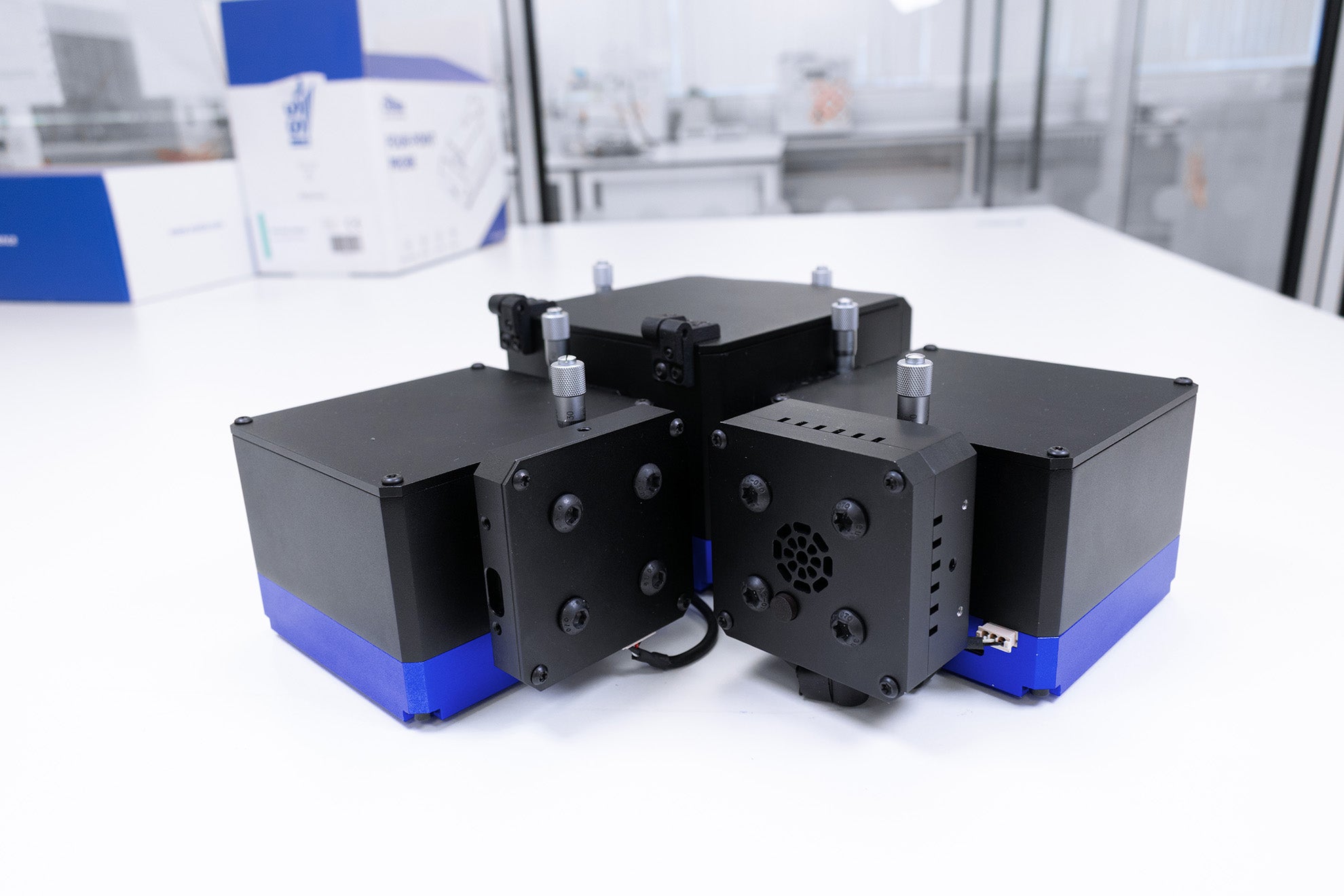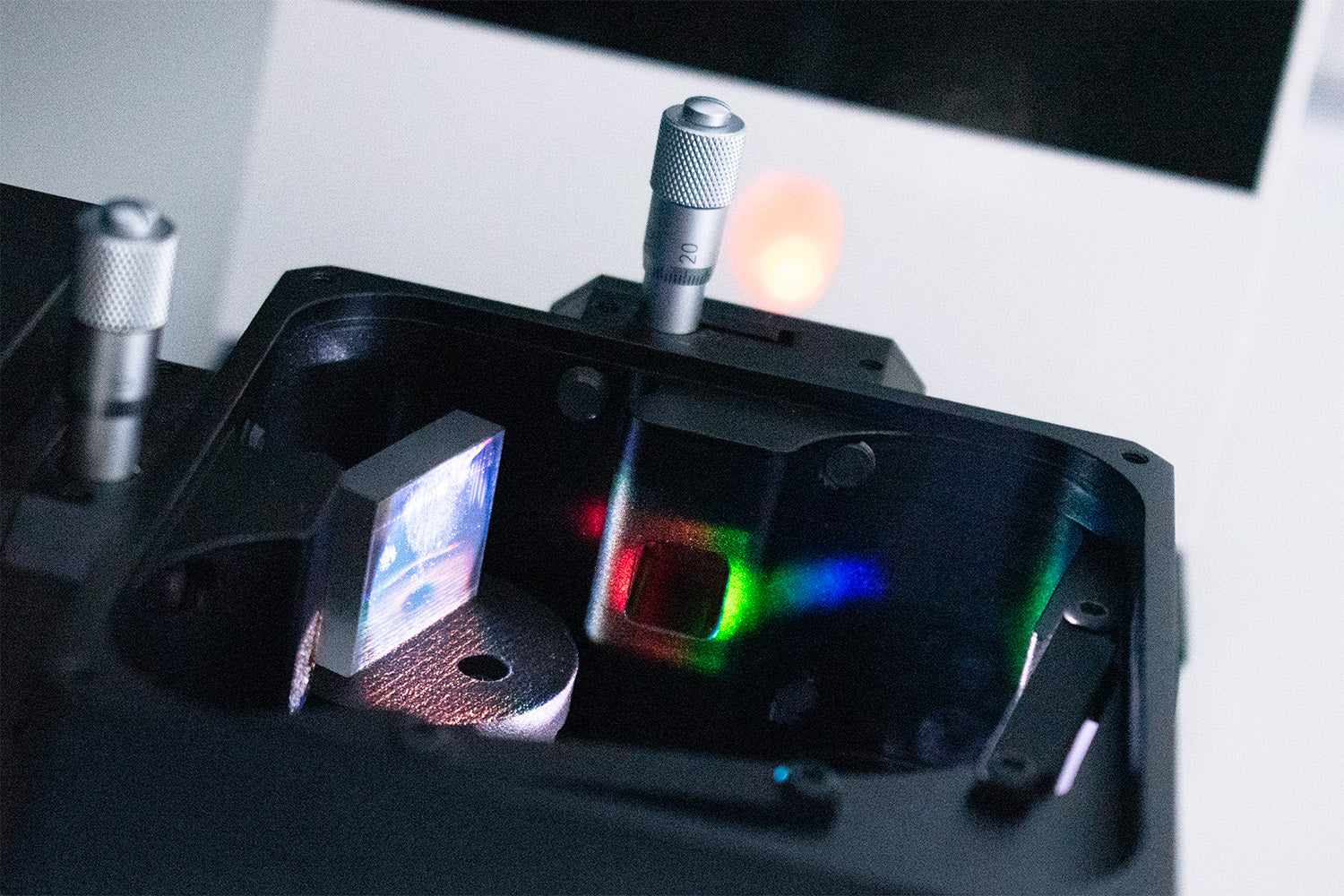Spectrofluorometers: Working Principles & Instrumentation

Jump to: How Does A Spectrofluorometer Work? | What Do Spectrofluorometers Measure? | Fluorescence Spectroscopy
Spectrofluorometer vs. Spectrophotometer | Find The Right Spectroscopy System For You
Spectrofluorometers are measurement instruments capable of taking both fluorescence, or photoluminescence, measurements and absorbance measurements, which high levels of accuracy and repeatability.
Spectrofluorometers contain a sample holder, multiple light sources and multiple single pixel detectors. In addition, to measure both absorbance and fluorescence as accurately as possible, spectrofluorometers use wavelength selection components such as monochromators.
Monochromators allow spectrofluorometers to select wavelengths of light individually either before or after passing through a sample. This allows for you to do many different spectroscopy measurements with one instrument, achieving a high level of accuracy and resolution.
How Does A Spectrofluorometer Work?


Spectrofluorometers contain the following components:
- Excitation sources (usually both a broadbands source and UV only sources)
- A sample holder
- A detector or multiple detectors
- Monochromators
The arrangement of these various components will depend on spectrofluorometer design and alignment.
Excitation Sources
Emission fluorescence spectroscopy requires an high energy excitation source with a narrow wavelength range to selectively excite fluorophores. For this, you will likely need a narrowband light emitter, such as a UV light source. However, using single wavelength sources alone limits the type of measurements you can do.
Absorbance measurements and excitation fluorescence measurements require a broadband light source. To conduct excitation fluorescence measurements, you can combine a broadband light source with a monochromator to select specific wavelengths for sample excitation. This monochromator will also increase the accuracy of absorbance measurements, by assessing transmission and absorbance of each wavelength individually. However, for fluorescence measurements, variable light sources may produce a less intense excitation signal, leading to a lower signal.
Spectrofluorometers, such as the Ossila Spectrofluorometer, usually have both an high energy UV light source and a variable light source option, allowing users to conduct a wider range of measurements with just one instrument.
Sample Holder
The sample holder is a straight-forward but vital part of the system. It ensures consistency between measurements and holds the sample steady. There are sample holders designed to measure substrates for thin film measurement. Additionally, many samples measure fluorescence within solution, usually in a quartz cuvette. Using ultra-flat quartz cuvettes or substrates helps to reduce reflection, scattering and absorbance of light. This ensures that the maximum possible light is transmitted through the holder without interaction.
Detectors
Spectrofluorometers use single pixel detectors, unlike spectrometers which use array detectors. Single pixel detectors can only measure intensity and have no way to decipher between different wavelengths of light. This makes spectrofluorometers more sensitive to smaller signals, but means that wavelength selection must take place before or after interacting with the sample.
For fluorescence measurements, detectors are combined with a monochromator. This means that the detector only measures light emitted at specific wavelengths, omitting the strong excitation wavelength. To produce a fluorescence spectra, a sample can be stimulated by a high energy light source, then scanning monochromators cycle through the different wavelengths as the detector measures the delivered intensity. This way the spectrofluorometer builds a fluorescence spectrum piece by piece.
For absorbance measurements, the light source must be able to pass through the sample directly into the detector. Therefore, for maximum versatility, some spectrofluorometers, such as the Ossila Spectrofluorometer, come with multiple detectors in different locations to facilitate both absorbance and fluorescence measurements.
Often photomultipliers are used as these detectors. The type of photomultipliers used will determine the spectral range and sensitivity of the spectrofluorometer.
All-In-One System
Spectrofluorometer components are often encased in a single unit or house, with a dedicated sample chamber. By combining these components in one system, you can ensure consistent alignment between components for more reliable measurement.
Another benefit of spectrofluorometers is that you can take different types of measurements with one instrument.
What Measurements Can Spectrofluorometers Do?
Spectrofluorometers can perform a variety of measurements:
- Fluorescence Spectroscopy
- Emission Spectra: If the excitation wavelength is fixed and the emission wavelength is varied, spectrofluorometers can measure the emission spectrum of a fluorophore. These measurements tell you about the light emitted from a fluorophore.
- Excitation Spectra: Where the measured emission wavelength remains the same (ideally where emission is strongest) but the excitation wavelength is varied. These measurements will tell you which wavelengths of light stimulate the most fluorescence.
-
Absorbance Spectroscopy
Spectrofluorometers can also measure absorbance, much like a spectrophotometer. This method takes longer than absorbance measurements taken with a USB spectrometer but with higher sensitivity and resolution as you can measure transmission intensity 1nm at a time.
Spectrofluorometers as Fluorescence Spectrometers
Spectrofluorometers are most commonly used in fluorescence spectroscopy. This is the study of fluorophores, either for use in fluorescent applications such as in LEDs, or as a marker to study biological processes or chemical reactions.
Fluorescence spectroscopy analyzes light emitted from a sample due to an excited electron relaxing from the first electronic state into the ground state. There are two types of fluorescence measurement: steady state fluorescence and time resolved fluorescence. Time resolved PL measurements are used to measure dynamic processes like fluorescence lifetime. Steady state fluorescence can be used to probe the molecular structure of a material and is measured using a spectrofluorometer.
Fluorescence spectroscopy is often used alongside absorbance spectroscopy, as absorbance measures the excited state of a molecule whereas fluorescence measurements probe the ground state.
Spectrofluorometer vs. Spectrophotometer
Spectrofluorometers are similar to spectrophotometers - often the terms are used interchangeably. They use the same components, and they build a spectrum in the same way. However, there are a few key differences between spectrofluorometers and spectrophotometers.
| Spectrofluorometers | Spectrophotometers | |
|---|---|---|
| Components |
|
|
| Suitable for Absorbance Measurements? | ||
| Suitable for Fluorescence Measurements? |
Both emission and excitation spectra High high resolution and accuracy |
Finding The Right Spectroscopy System For You

The terms spectrometer, a spectrophotometer, or spectrofluorometer are often used interchangeably, and every system will have different designs and specifications.
As with most measurement equipment, this comes down to your experimental needs, lab space and budget. Simple spectrometers such as the Ossila USB spectrometer can be incorporated into modular optical systems, and are a cost-effective way to take simple optical spectroscopy measurements. However, they lack the resolution and accuracy of most spectrofluorometers.
Spectrofluorometers are versatile pieces of equipment. They are more costly than modular spectrometers but provide higher resolution, accuracy and consistency in all measurements.
Monochromator

More Resources
Fluorescence spectroscopy is used to measure fluorescence. The technique often used together with absorbance spectroscopy. Fluorescence is a type of photoluminescence where light is quickly reemitted from a material after incident photons are absorbed. This is different to phosphorescence where there is a delay between photon absorption and emission. The term fluorescence is often used interchangeably with photoluminescence.
Read more...A spectrophotometer is a piece of equipment used to quantify the absorbance of light by a sample. Spectrophotometers can be used to: identify materials by mapping molecular absorption profiles, work out solute concentrations of solutions, detect trace impurities in samples or follow the progress of chemical reactions.
Read more...